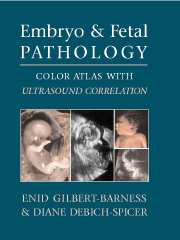Book contents
- Frontmatter
- Contents
- Foreword by John M. Opitz
- Preface
- Acknowledgments
- 1 The Human Embryo and Embryonic Growth Disorganization
- 2 Late Fetal Death, Stillbirth, and Neonatal Death
- 3 Fetal Autopsy
- 4 Ultrasound of Embryo and Fetus: General Principles
- 5 Abnormalities of Placenta
- 6 Chromosomal Abnormalities in the Embryo and Fetus
- 7 Terminology of Errors of Morphogenesis
- 8 Malformation Syndromes
- 9 Dysplasias
- 10 Disruptions and Amnion Rupture Sequence
- 11 Intrauterine Growth Retardation
- 12 Fetal Hydrops and Cystic Hygroma
- 13 Central Nervous System Defects
- 14 Craniofacial Defects
- 15 Skeletal Abnormalities
- 16 Cardiovascular System Defects
- 17 Respiratory System
- 18 Gastrointestinal Tract and Liver
- 19 Genito-Urinary System
- 20 Congenital Tumors
- 21 Fetal and Neonatal Skin Disorders
- 22 Intrauterine Infection
- 23 Multiple Gestations and Conjoined Twins
- 24 Metabolic Diseases
- Appendices
- Index
19 - Genito-Urinary System
Published online by Cambridge University Press: 23 February 2010
- Frontmatter
- Contents
- Foreword by John M. Opitz
- Preface
- Acknowledgments
- 1 The Human Embryo and Embryonic Growth Disorganization
- 2 Late Fetal Death, Stillbirth, and Neonatal Death
- 3 Fetal Autopsy
- 4 Ultrasound of Embryo and Fetus: General Principles
- 5 Abnormalities of Placenta
- 6 Chromosomal Abnormalities in the Embryo and Fetus
- 7 Terminology of Errors of Morphogenesis
- 8 Malformation Syndromes
- 9 Dysplasias
- 10 Disruptions and Amnion Rupture Sequence
- 11 Intrauterine Growth Retardation
- 12 Fetal Hydrops and Cystic Hygroma
- 13 Central Nervous System Defects
- 14 Craniofacial Defects
- 15 Skeletal Abnormalities
- 16 Cardiovascular System Defects
- 17 Respiratory System
- 18 Gastrointestinal Tract and Liver
- 19 Genito-Urinary System
- 20 Congenital Tumors
- 21 Fetal and Neonatal Skin Disorders
- 22 Intrauterine Infection
- 23 Multiple Gestations and Conjoined Twins
- 24 Metabolic Diseases
- Appendices
- Index
Summary
MALFORMATIONS
Horseshoe Kidney
A horseshoe kidney is a single, midline, horseshoe-shaped kidney.
The kidney is formed by an interaction between the ureteric bud and the metanephric blastema (Figures 19.1 to 19.3). If the ureteric buds are located more medially than normal or if the inducible metanephric blastema is continuous at the lower pole, then a fused horseshoe kidney may develop.
The horseshoe kidney is usually at a lower level than normal kidneys. Its renal pelves are displaced anteriorly and its ureters usually course across the anterior surfaces of the kidney. Dysplastic development may occur in the fused portion of the kidney.
The ureters may be duplicated or angulated, so that obstruction, which leads to hydronephrosis, occurs.
Ectopic Kidney
A kidney is ectopic when it is in the pelvis and not in its usual location. Ureter duplication is a double ureter that can be unilateral or bilateral. Ectopic kidney and ureter duplication usually are not functionally important in the prenatal period. Their frequency is increased in chromosome aneuploidies.
Renal Agenesis
In bilateral renal agenesis, both kidneys and ureters are absent (Table 19.1).
Bilateral renal agenesis is rare, occurring in 1/3,000 to 1/4,000 live borns (Figure 19.4). Unilateral agenesis occurs in 1/1,000 newborns; it is more common in males.
It is postulated that renal agenesis is caused by the failure of the ureteric bud to develop. The ureteric bud normally induces the metanephric blastema to become a kidney.
- Type
- Chapter
- Information
- Embryo and Fetal PathologyColor Atlas with Ultrasound Correlation, pp. 513 - 545Publisher: Cambridge University PressPrint publication year: 2004



